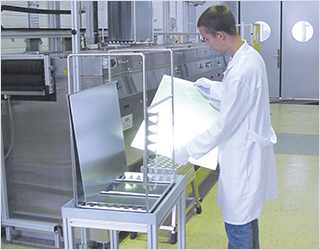In-line plant for wet chemical surface treatment prior to coating



One main area of work of the Fraunhofer FEP is the development of coatings to provide a wide variety of substrates with new or improved functions. Customized cleaning prior to any coating step is vital in order to ensure the resulting adhesion of the layer systems.
Cleaning is therefore an important step in the value-creation chain and is the basis for minimizing rejects, lowering costs, and manufacturing high-quality products.
A wide variety of contaminants, some of which are at the atomic level, and differing requirements on the surfaces demand a spectrum of cleaning processes in order to achieve optimum results.
CLAIRE, our in-line cleaning plant, brings together a number of wet chemical methods for the optimal cleaning of metal sheets, metal strips, and small components made of metal, glass, and plastic. The cleaning processes are fully automatic, with a cleaning bath and process monitoring system.